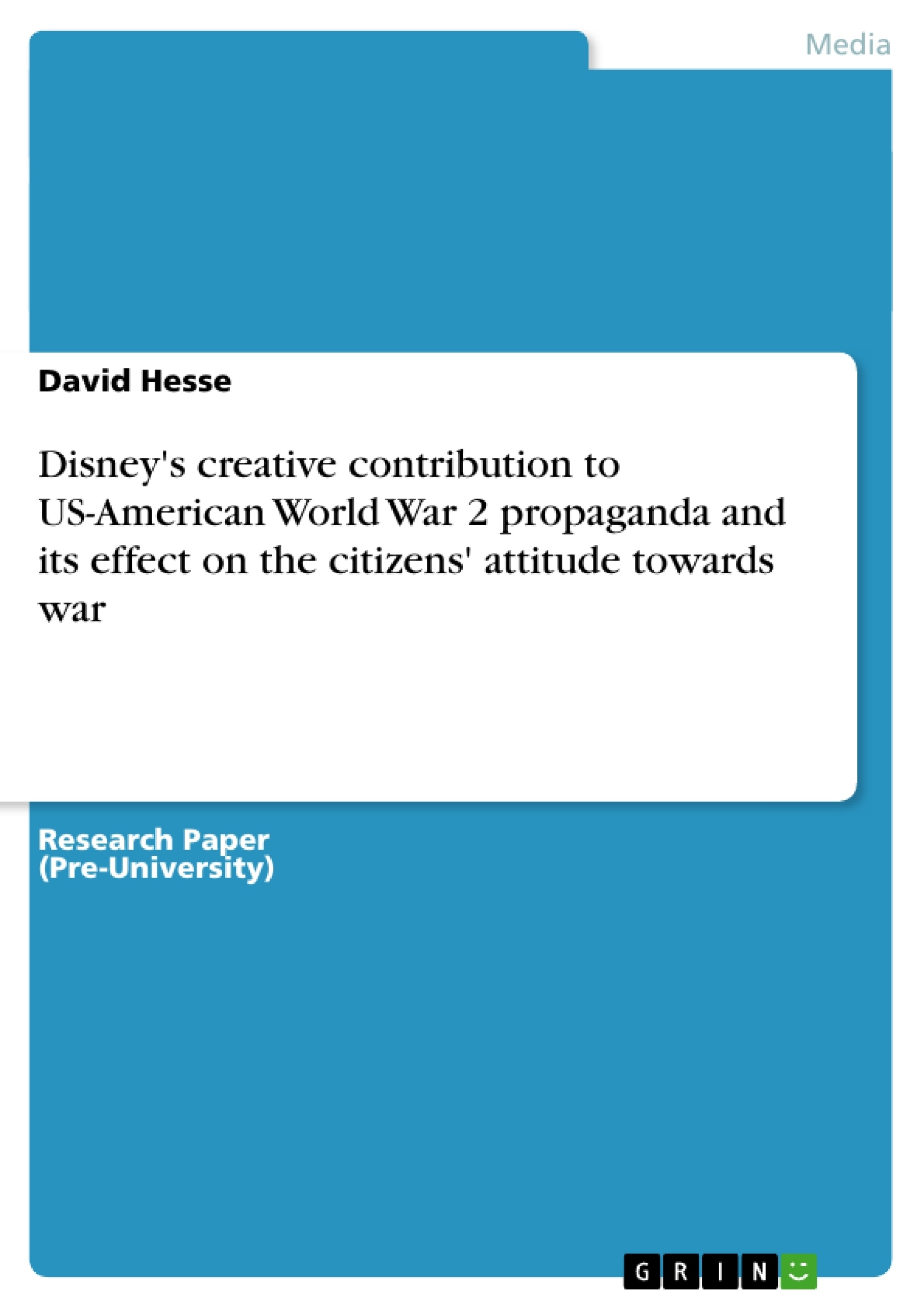When I was to decide for a topic to be dealt with in my ‘Facharbeit’, the decision was clear: Including my interest in the history and pop culture of the United States of America, Disney’s World War 2 cartoons offer a great potential to be researched intensively as one can find a lot of background knowledge, regarding the history of the Disney studios and the general historical context. Also, there is a broad mass of cartoons to be analyzed and looked at closely. Questioning the justification for family cartoons to be used as propaganda material, I further have a firm opinion. However, in order not to go beyond the scope, I must, unfortunately, leave out several relevant and interesting aspects to the topic and do not make any claims for completeness.
In the following, I would like to elucidate my approach towards the issue: To begin with, I focus on general, historical facts about the US-American World War 2 propaganda and Disney’s contribution to the war effort, giving basic background information, in order to understand and interpret two war-time cartoons which perfectly exemplify the convincing way most propaganda cartoons worked and appealed to the citizens. Being two of the most popular shorts during World War 2 (one of them even honored with an Oscar) and rather focusing on entertainment, instead of war instructions, both Der Fuehrer’s Face and Reason and Emotion are great fun to watch and very suitable for a detailed interpretation. Eventually, I comment on the general justification of those cartoons and sum up my results.
Inhaltsverzeichnis
- My fascination for historical Disney cartoons
- US-American World War 2 propaganda
- General definition of the term 'propaganda'
- Common forms of US-American war-time propaganda, (governmental) propagandists, and their overall messages and goals
- Disney's contribution to the war effort
- The studios during wartime
- Walt Disney's propaganda ideas
- Cartoon analysis
- Der Fuehrer's Face (1943)
- Content
- Shots, stylistic devices/figures, tone: and the effect on the viewer
- Historical background: events, personalities, and figures
- Reason and Emotion (1943)
- Content
- Shots, stylistic devices/figures, tone: and the effect on the viewer
- Historical background: events, personalities, and figures
- Der Fuehrer's Face (1943)
- Was it justified to "misuse" family cartoons as propaganda material?
- Recapping the results
- Bibliography
Zielsetzung und Themenschwerpunkte
Die Facharbeit befasst sich mit dem Einfluss von Disneys propagandistischer Kreativität auf die US-amerikanische Kriegsführung im Zweiten Weltkrieg und untersucht, wie diese die Einstellung der Bürger zum Krieg beeinflusste. Die Arbeit analysiert Disneys Beitrag zur Kriegsanstrengung und untersucht zwei seiner wichtigsten Propagandafilme, "Der Fuehrer's Face" und "Reason and Emotion", um die Wirkungsweise von Propagandafilmen zu verstehen.
- Die Rolle von Propaganda im Zweiten Weltkrieg in den USA
- Disneys Beitrag zur US-amerikanischen Kriegsanstrengung
- Die Analyse von "Der Fuehrer's Face" und "Reason and Emotion"
- Die ethische Diskussion der Verwendung von Familiencartoons als Propagandamittel
- Die Auswirkungen von Disneys Propaganda auf die Einstellung der Bürger zum Krieg
Zusammenfassung der Kapitel
Die Facharbeit beginnt mit einer persönlichen Einführung des Autors, der seine Faszination für historische Disney-Cartoons schildert und die Motivation für die Arbeit erläutert. Im Anschluss werden die Grundlagen der US-amerikanischen Propaganda im Zweiten Weltkrieg beleuchtet, wobei die allgemeine Definition des Begriffs "Propaganda" sowie die verschiedenen Formen und Ziele der US-amerikanischen Kriegszeitpropaganda im Fokus stehen.
Im dritten Kapitel wird Disneys Beitrag zur Kriegsanstrengung näher beleuchtet. Hierbei werden die Aktivitäten der Disney Studios während des Krieges, die Produktionsmethoden und die verschiedenen Arten von Filmen, die für das Militär und die Zivilbevölkerung produziert wurden, beschrieben. Auch Disneys eigene Propagandaideen werden in diesem Kapitel vorgestellt.
Die Kapitel vier und fünf widmen sich der detaillierten Analyse von zwei ausgewählten Propagandafilmen: "Der Fuehrer's Face" und "Reason and Emotion". Die Analyse umfasst die Inhaltsbeschreibung, die stilistischen Mittel, den Ton und die Wirkung auf den Zuschauer sowie den historischen Hintergrund der Filme.
Im sechsten Kapitel wird die ethische Frage diskutiert, ob es gerechtfertigt war, Familiencartoons als Propagandamittel zu "missbrauchen". Hierbei werden die Argumente für und gegen die Verwendung von Cartoons als Propaganda gewogen.
Schlüsselwörter
Die Schlüsselwörter und Schwerpunktthemen des Textes umfassen die US-amerikanische Propaganda im Zweiten Weltkrieg, Disneys Beitrag zur Kriegsanstrengung, die Analyse von "Der Fuehrer's Face" und "Reason and Emotion", die ethische Diskussion der Verwendung von Familiencartoons als Propagandamittel und die Auswirkungen von Disneys Propaganda auf die Einstellung der Bürger zum Krieg.
- Citation du texte
- David Hesse (Auteur), 2014, Disney's creative contribution to US-American World War 2 propaganda and its effect on the citizens' attitude towards war, Munich, GRIN Verlag, https://www.grin.com/document/271582
-

-

-

-
Téléchargez vos propres textes! Gagnez de l'argent et un iPhone X. -

-
Téléchargez vos propres textes! Gagnez de l'argent et un iPhone X. -

-
Téléchargez vos propres textes! Gagnez de l'argent et un iPhone X. -

-
Téléchargez vos propres textes! Gagnez de l'argent et un iPhone X. -

-
Téléchargez vos propres textes! Gagnez de l'argent et un iPhone X. -

-
Téléchargez vos propres textes! Gagnez de l'argent et un iPhone X.

